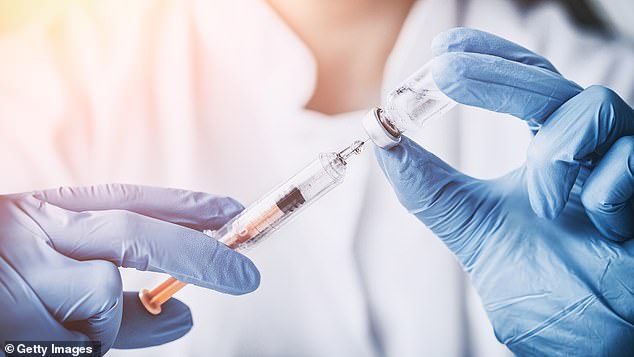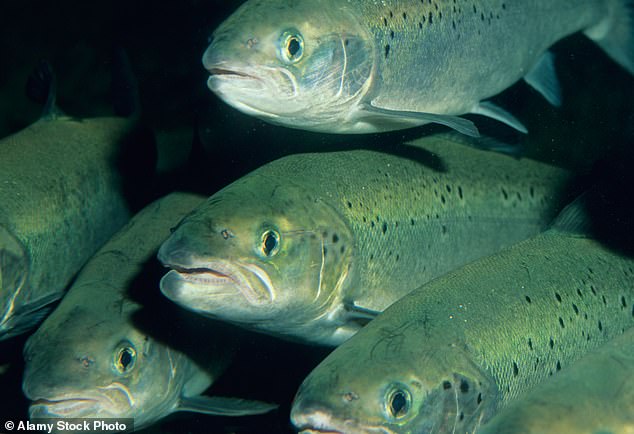From Stanley Tucci to Terry Crews, some men have made baldness their signature style.
But if you’re not so keen to say goodbye to your luscious locks just yet, perhaps it’s time to consider injecting your scalp with salmon sperm.
For years advocates have claimed the wrinkle-defying treatment—known medically as polynucleotides—offers a ‘natural’ alternative for face ‘tweakments’ such as Botox and filler.
Now experts say it can stimulate body cells to regenerate tissue and ‘promote the growth of healthier hair’.
MailOnline has found clinics in the UK offering the treatment to men and women for £400.
The treatments use purified and sterilised DNA molecules extracted from salmon or trout sperm, known as polynucleotides, which have anti-inflammatory effects.
When polynucleotides are injected into human skin, fibroblasts are activated.
Fibroblasts are stretchy molecules found in skin that help to maintain the structural framework of the tissue. As we age these fibroblasts decrease.

Salmon sperm injections are the latest weapon being used in the fight against hair loss (stock image)
So, when the polynucleotides are injected under the eyes, in the cheekbones or in the neck, it theoretically ‘rejuvenates’ the skin.
South Korea’s aesthetics sector has been using the treatment for over a decade, and it’s now gaining popularity among Western clients.
Dr Gizem Seymenoglu, an aesthetician and hair loss specialist at Longevita Hair Transplant clinic in London said: ‘A shallow injection of 1mm depth will rejuvenate the scalp by boosting collagen production, but it will not reach the hair follicles or activate them.
‘For salmon sperm injections to be truly effective for your hair, they need to be injected at a depth of 3 to 4 mm.
‘But of course, adjustments might be necessary depending on the thickness of a person’s scalp.’
Most people are advised to undergo a course of three or four treatments, visiting their practitioner regularly, roughly every fortnight or four weeks depending on their current state of hair loss.
Each treatment lasts around half an hour, but, as with any medical or aesthetic treatment, it is not without its risks.
Known side effects can include minor bleeding, bruising, discomfort and headaches.
While hair loss is usually associated with ageing, dermatologists have said they are increasingly seeing younger men seeking help for the problem.

Polynucleotides typically uses purified and sterilised DNA molecules extracted from salmon or trout sperm (file photo)
Some going to the extreme, and expensive length, of getting hair transplants.
It’s estimated that around a quarter of men in their 20s show signs of balding — but by the age of 50, that figure rises to 85 per cent of men.
Androgenetic alopecia is the most common type of hair loss in men — also known as male pattern baldness — and is believed to affect around 40 to 50 per cent of men worldwide.
It causes a receding hairline at the front and a bald patch on the crown of the head which gradually gets bigger forming a distinct U-shape on the head.
The condition is caused by a combination of genetic factors and levels of sex hormones which gradually lead to the permanent loss of hair follicles on the head.
Patients can use the topical treatment minoxidil, sold as Rogaine, but this can be slow and does not work for everyone suffering from hair loss.
Those who do not see improvements with minoxidil can also take the oral drug Finasteride, sold as Propecia, which works by decreasing the flow of testosterone.
There are other tweakments available for treating hair loss, such as platelet-rich plasma (PRP), which involves taking a vial of blood and, using a centrifuge, isolating the nutrient rich platelets.
These are then injected back into the body—or in this case, scalp—to promote healing.
According to Dr Seymenoglu, this is comparable to how salmon sperm injections work.
She said: ‘Just like platelet-rich plasma injections, salmon sperm injections can be used on the scalp, and, in fact, salmon DNA injections work in a manner similar to PRP.
‘They won’t hydrate or volumise your hair, but they will stimulate your body’s own cells to regenerate tissue wherever they are injected.
‘So, when these are used correctly on the scalp, they can stimulate hair follicles, accelerate the hair growth cycle and promote the growth of healthier hair.
‘Though unlike PRP, these injections won’t improve the thickness of your hair shaft.’











